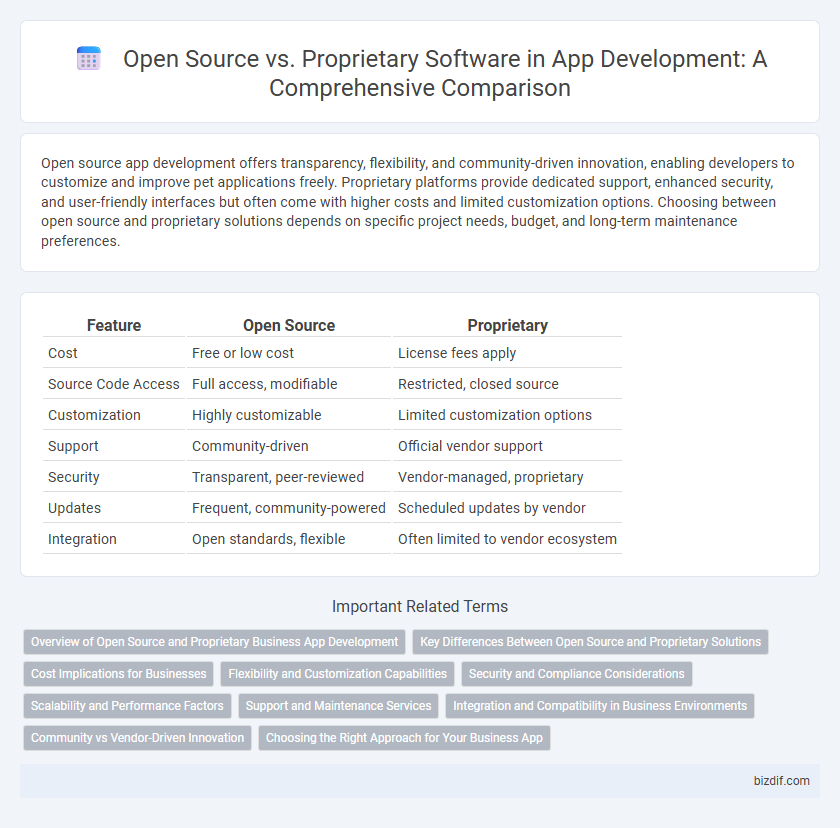Open source app development offers transparency, flexibility, and community-driven innovation, enabling developers to customize and improve pet applications freely. Proprietary platforms provide dedicated support, enhanced security, and user-friendly interfaces but often come with higher costs and limited customization options. Choosing between open source and proprietary solutions depends on specific project needs, budget, and long-term maintenance preferences.
Table of Comparison
| Feature | Open Source | Proprietary |
|---|---|---|
| Cost | Free or low cost | License fees apply |
| Source Code Access | Full access, modifiable | Restricted, closed source |
| Customization | Highly customizable | Limited customization options |
| Support | Community-driven | Official vendor support |
| Security | Transparent, peer-reviewed | Vendor-managed, proprietary |
| Updates | Frequent, community-powered | Scheduled updates by vendor |
| Integration | Open standards, flexible | Often limited to vendor ecosystem |
Overview of Open Source and Proprietary Business App Development
Open source business app development leverages publicly available codebases, enabling collaboration, rapid innovation, and cost-effective customization tailored to specific organizational needs. Proprietary app development involves creating exclusive software owned by a company, providing controlled features, dedicated support, and enhanced security but often with higher upfront costs and limited flexibility. Choosing between open source and proprietary solutions depends on business priorities such as budget, scalability, integration requirements, and long-term maintenance strategies.
Key Differences Between Open Source and Proprietary Solutions
Open source app development offers full access to the source code, enabling customization, community collaboration, and cost-effective scalability, while proprietary solutions restrict code access, providing standardized features and dedicated vendor support. Open source platforms typically foster faster innovation through transparent development and community-driven updates, whereas proprietary software emphasizes controlled environments with predictable performance and licensing fees. Security models differ as open source relies on community vetting, whereas proprietary solutions implement centralized security protocols and accountability.
Cost Implications for Businesses
Open source app development significantly reduces upfront costs by eliminating licensing fees, enabling businesses to allocate budget towards customization and support. Proprietary software often involves recurring expenses such as licenses, maintenance, and vendor support, which can increase total cost of ownership over time. Evaluating long-term cost implications, including scalability and flexibility, is crucial for businesses when choosing between open source and proprietary development models.
Flexibility and Customization Capabilities
Open source app development offers unparalleled flexibility and customization capabilities, enabling developers to modify source code and tailor applications to specific user needs. Proprietary software often limits these options due to restricted access to the underlying code, constraining the ability to innovate or adapt quickly. Choosing open source empowers rapid iteration and integration with diverse technologies, enhancing overall development agility.
Security and Compliance Considerations
Open source app development offers transparency through public code access, enabling thorough security audits and faster vulnerability identification, which enhances compliance with industry standards like GDPR and HIPAA. Proprietary solutions often provide dedicated security support and tailored compliance features, but lack the community-driven scrutiny that may uncover hidden risks. Choosing between open source and proprietary depends on organizational priorities regarding control, flexibility, and regulatory adherence in app security frameworks.
Scalability and Performance Factors
Open source app development offers high scalability through customizable codebases that allow seamless integration of new features and optimizations tailored to specific performance requirements. Proprietary solutions often provide optimized performance out-of-the-box with dedicated support but may face limitations in scaling due to closed architectures and licensing constraints. Evaluating the trade-offs between open source flexibility and proprietary stability is critical for achieving desired scalability and sustained high performance in application development.
Support and Maintenance Services
Open source app development often benefits from a global community providing continuous updates, bug fixes, and diverse support forums, ensuring rapid issue resolution and innovation. Proprietary software relies on dedicated vendor support teams with structured maintenance contracts, offering guaranteed response times and specialized assistance tailored to business needs. Choosing between the two hinges on evaluating the importance of customizable, community-driven support versus formal, accountable maintenance services.
Integration and Compatibility in Business Environments
Open source app development offers seamless integration with diverse business systems through customizable APIs and community-driven plugins, enhancing compatibility across multiple platforms. Proprietary solutions usually provide dedicated support and standardized interfaces, ensuring stable integration within specific enterprise environments but may limit flexibility with other tools. Choosing between open source and proprietary depends on the business's need for adaptability versus controlled, vendor-supported compatibility.
Community vs Vendor-Driven Innovation
Open source app development thrives on community-driven innovation, leveraging diverse contributions that accelerate feature updates and enhance security through collective scrutiny. Proprietary development relies on vendor-driven innovation, where a centralized team controls the roadmap, ensuring cohesive integration and dedicated support but potentially slower adaptation to emerging trends. Community collaboration fosters transparency and customization, while vendor control prioritizes stability and proprietary advantage in competitive markets.
Choosing the Right Approach for Your Business App
Choosing between open source and proprietary app development depends on your business goals, budget, and customization needs. Open source offers flexibility, lower costs, and community support, making it ideal for startups or projects requiring rapid iteration. Proprietary solutions provide dedicated support, enhanced security, and tailored features, benefiting enterprises with specific compliance or integration requirements.
Open Source vs Proprietary Infographic

 bizdif.com
bizdif.com